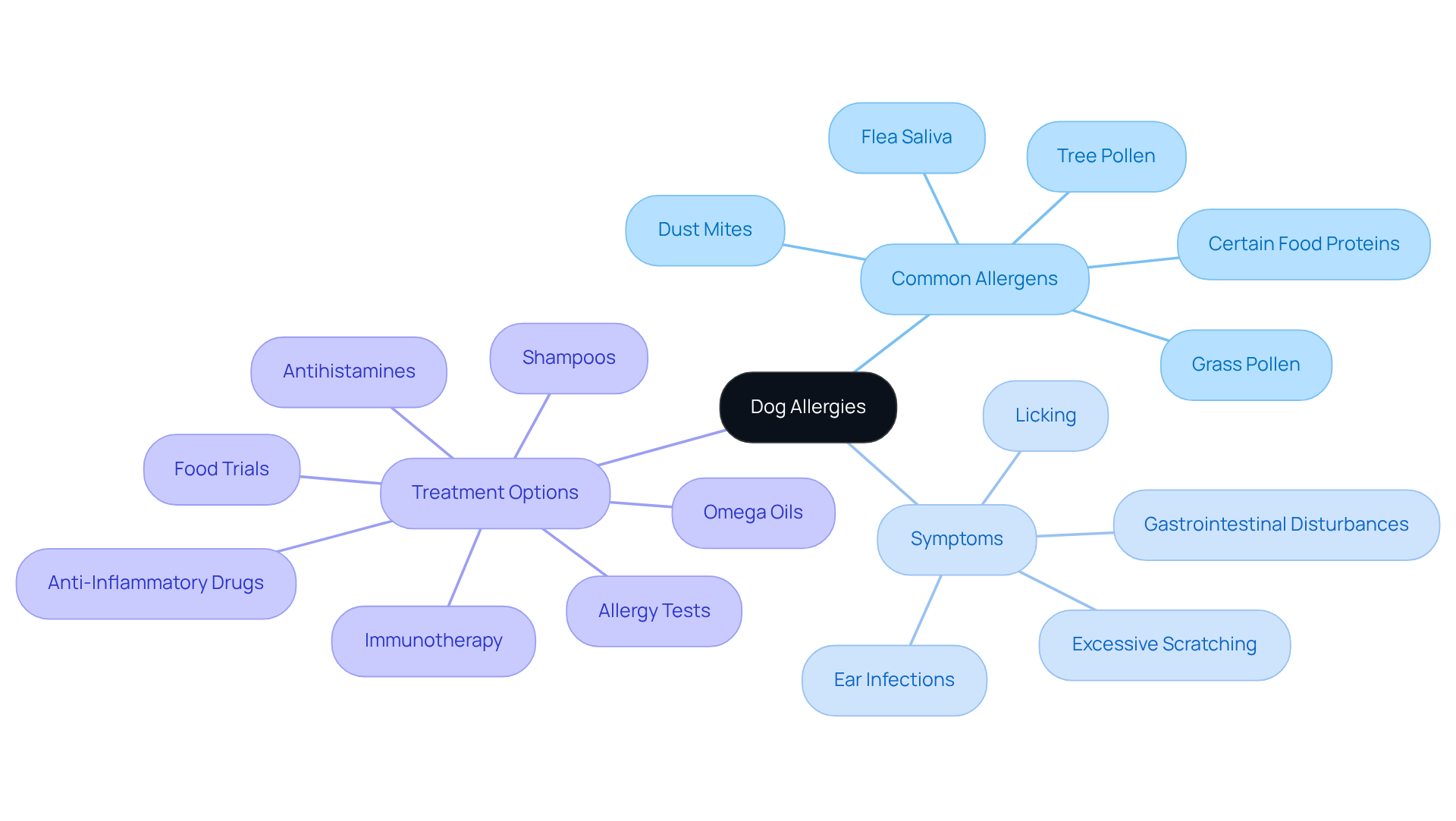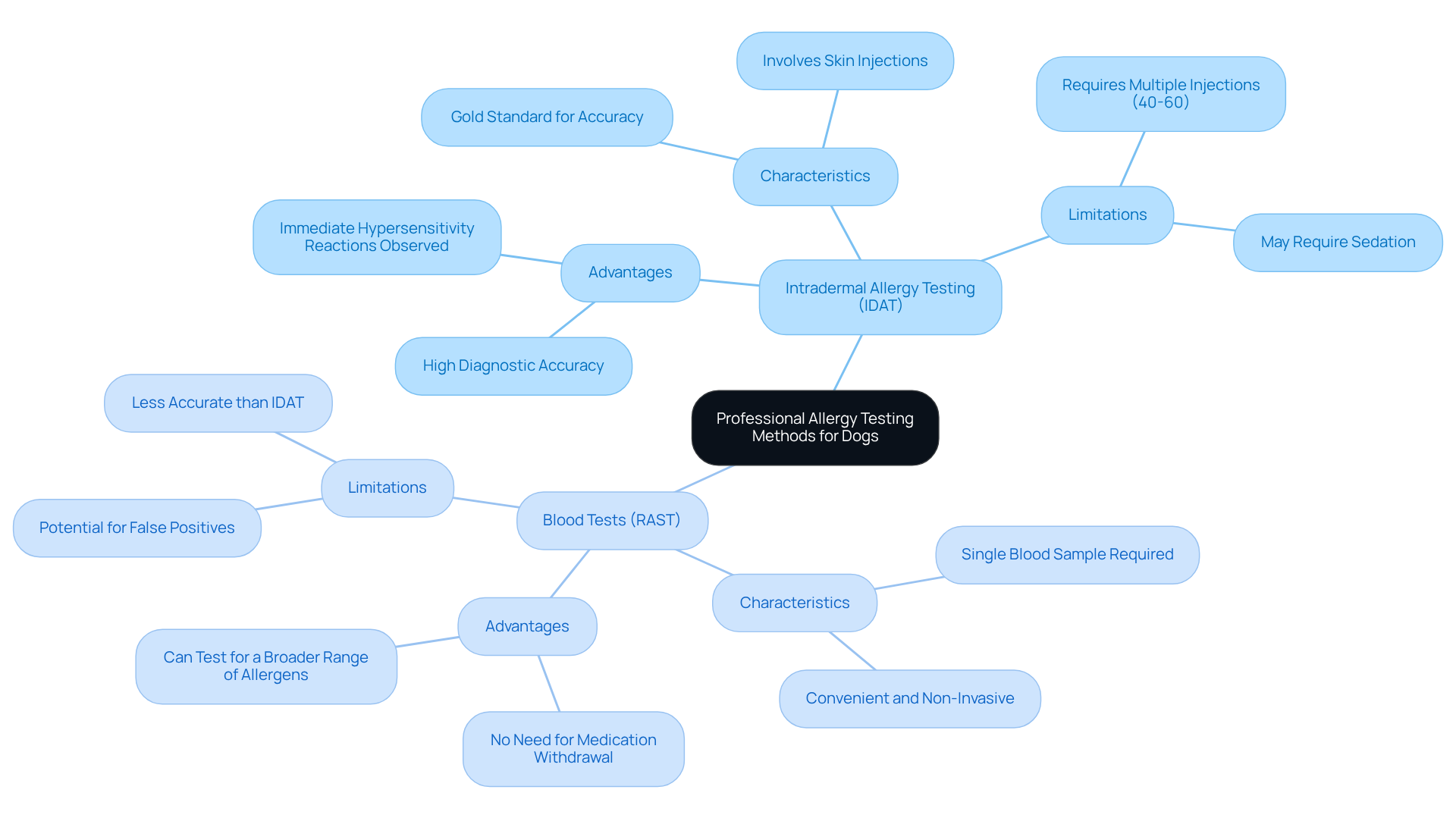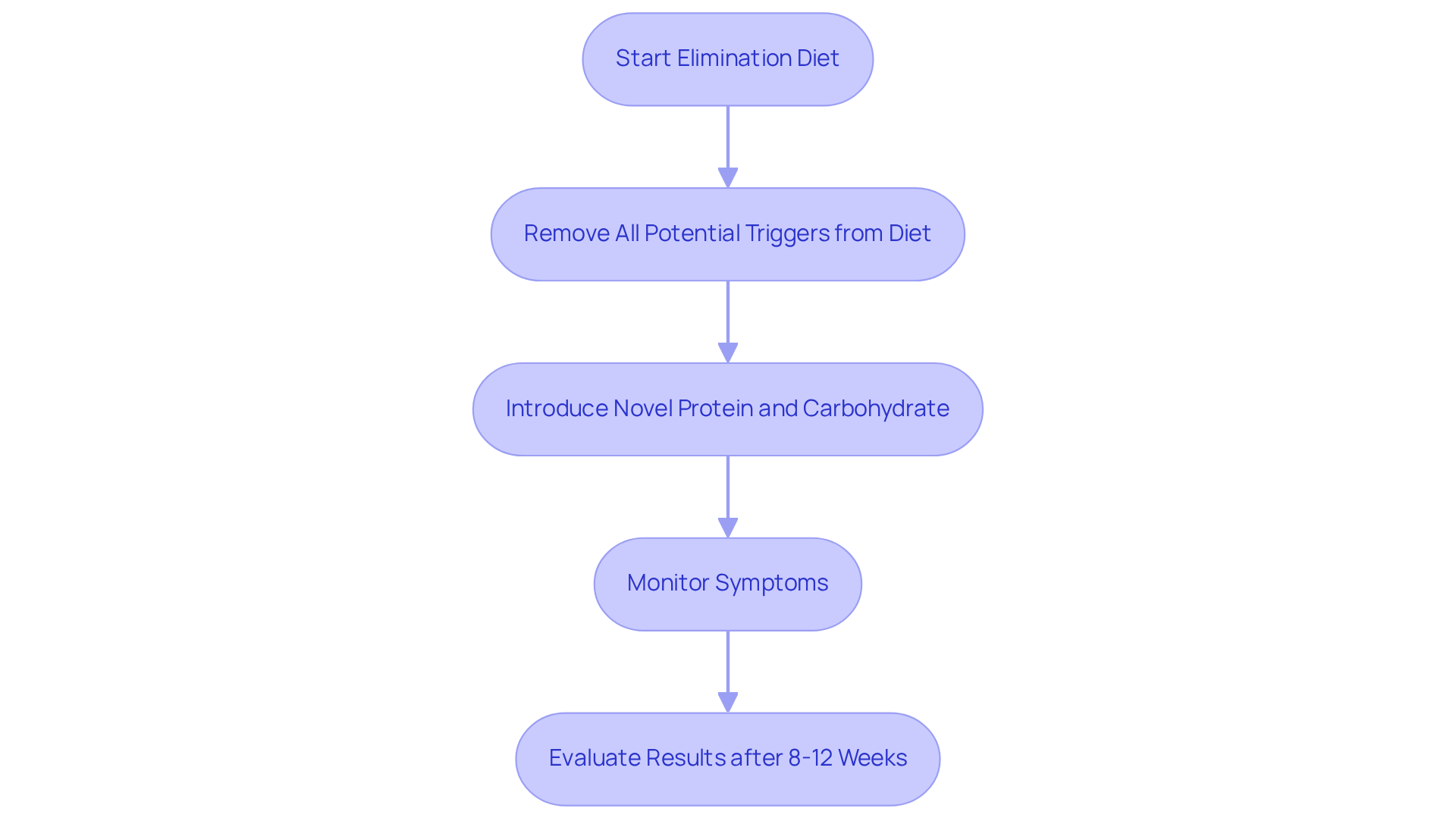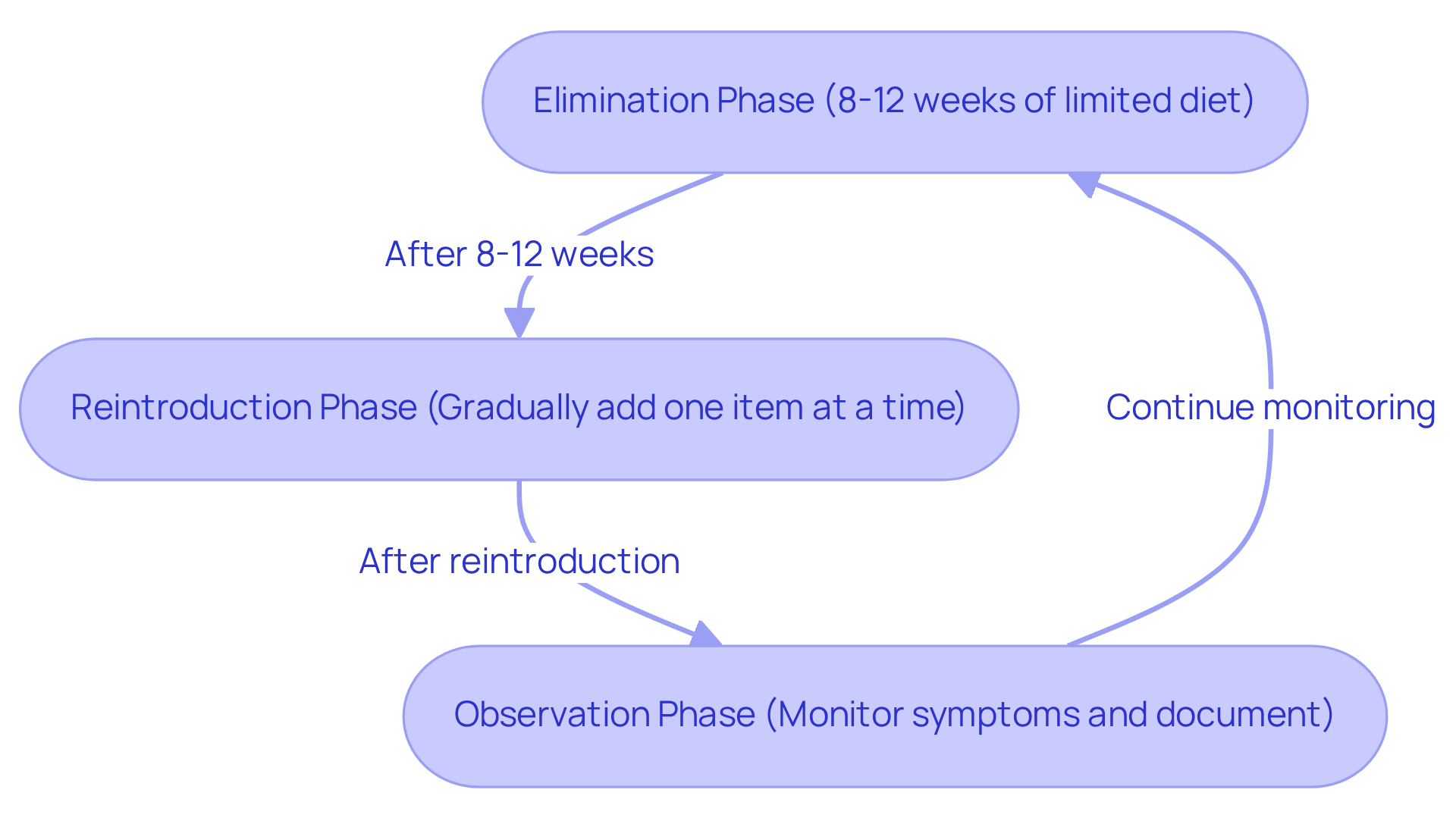Master the Allergy Test for Dogs: Essential Steps and Insights
Overview
This article serves as a compassionate guide for pet owners navigating the allergy testing process for their beloved dogs. It highlights the essential steps and insights necessary to master this journey, such as:
- Recognizing symptoms
- Understanding various testing methods
- Implementing dietary elimination trials
By emphasizing the importance of identifying allergens through professional tests like intradermal allergy testing and blood tests, it reassures pet owners that they are not alone in this process. The structured elimination diet approach is also discussed, illustrating how these combined efforts can significantly enhance the quality of life for dogs suffering from allergies. Ultimately, these strategies enable targeted treatment and management, ensuring that your furry family members receive the care they deserve.
Introduction
Understanding the complexities of dog allergies is vital for pet owners who want their furry family members to lead happy, healthy lives. A significant portion of the canine population is affected by various allergens—from environmental irritants like pollen to specific food proteins. Recognizing the signs and symptoms is the first step toward effective management.
However, navigating the maze of allergy testing methods and treatment options can feel overwhelming. How can you determine the best approach to diagnose and alleviate your dog’s allergies while ensuring they receive the care they deserve?
This article explores essential steps and insights for mastering the allergy test for dogs, empowering you to make informed decisions for your beloved pets.
Explore the Basics of Dog Allergies
An allergy test for dogs can help identify how dog allergies manifest in various ways, primarily affecting your furry family members’ skin, gastrointestinal tract, and respiratory system. Common allergens include:
- tree pollen
- grass pollen
- dust mites
- certain food proteins
- flea saliva
You may notice symptoms such as excessive scratching, licking, ear infections, and gastrointestinal disturbances. It’s important to know that the majority of canines encounter these challenges at some stage in their lives. Notably, environmental sensitivities impact roughly 10-15% of the canine population, with specific breeds, like West Highland White Terriers and Labrador Retrievers, showing greater susceptibility.
Recognizing these signs is crucial for pet owners, as an allergy test for dogs can enable early intervention that significantly enhances your dog’s quality of life. A case study highlighted that most dogs develop sensitivities between the ages of 1 and 2 years, although symptoms can emerge as early as 4 months or as late as 7 years. This variability underscores the importance of vigilant observation and timely veterinary consultations.
Veterinarians emphasize understanding these allergens and their effects. As one noted, ‘Veterinarians are not just animal doctors; they are animal advocates.’ This perspective reinforces the role of veterinary professionals in assisting pet owners with the complexities of managing sensitivities. Effective treatment options may include:
- an allergy test for dogs
- food trials
- antihistamines
- omega oils
- anti-inflammatory drugs
- shampoos
- immunotherapy
By staying informed and proactive, you can ensure your furry companions receive the nurturing care they deserve.

Examine Professional Allergy Testing Methods
When it comes to the health of your furry family members, understanding their sensitivities is crucial. Professional allergy tests for dogs primarily utilize two methods: intradermal allergy testing (IDAT) and blood tests, commonly known as RAST (radioallergosorbent test). IDAT involves injecting small quantities of substances into the skin and monitoring for reactions, establishing it as the gold standard for accuracy. This technique allows veterinarians to observe immediate hypersensitivity reactions, providing clear insights into specific substances that may affect your beloved pet.
On the other hand, blood tests assess the immune reaction to triggers through a single blood sample. This method offers convenience, as it does not require sedation or the cessation of medications. Recent advancements in blood testing, including improved assay techniques and the ability to test for a broader range of allergens, have significantly enhanced accuracy. Many tests can now provide reliable results without the need for pets to stop their medications beforehand. However, it’s important to remember that while blood tests can be helpful, they may yield false positives and are not always as precise as IDAT.
Veterinarians often recommend a combination of both testing techniques, including an allergy test for dogs, to achieve a comprehensive assessment, especially in cases where symptoms are complex or when a dog has a history of various sensitivities. For instance, a study involving 34 canines with atopic dermatitis underscored the importance of correlating results from both IDAT and blood tests to improve diagnostic accuracy.
Looking ahead, advancements in intradermal sensitivity testing are set to refine the process even further, allowing for more precise identification of triggers and tailored treatment plans. Veterinarians emphasize that while both testing methods have their benefits, the choice ultimately hinges on your individual dog’s symptoms and medical history. Notably, as many as 10% of canines in the UK experience atopy, highlighting the prevalence of sensitivities and the need for personalized testing approaches. As Dr. Rebecca Mount wisely notes, understanding the nuances of these tests is essential for effectively managing sensitivities, as there is no one-size-fits-all solution for canine reactions.
By prioritizing your pet’s health and seeking the right testing methods, you can ensure a nurturing environment for your furry family members.

Implement Home Allergy Testing: The Elimination Diet Approach
Implementing an allergy test for dogs can be a systematic and compassionate way to identify dietary sensitivities through an elimination diet. This trial should ideally last between 8 to 12 weeks, during which you’ll want to remove all potential triggers from your dog’s diet. It’s important to introduce a novel protein and carbohydrate source that your furry friend has never had before, such as venison, sweet potatoes, kangaroo, or lamb. This careful approach allows you to monitor any changes in symptoms that may indicate dietary sensitivities.
To achieve the most accurate results, sticking strictly to the elimination diet is essential. This means avoiding all treats, flavored medications, and any other items that could introduce hidden allergens. Throughout this process, careful monitoring and documentation of your dog’s symptoms will be key to understanding their needs.
Veterinary specialists emphasize that dietary sensitivities, which can be diagnosed with an allergy test for dogs, are among the most common issues affecting our canine companions, with proteins from dairy, beef, chicken, and wheat gluten often being the main culprits. Research has shown that many dogs may develop sensitivities after prolonged exposure to certain ingredients. By following a well-structured elimination diet, you can effectively identify and manage your dog’s dietary sensitivities, and this process may lead you to consider an allergy test for dogs, ultimately resulting in improved health and a better quality of life.
Consider the real-world benefits of this approach. Many dogs that once suffered from chronic skin irritations or digestive issues often show remarkable improvement once allergens are identified and removed from their diet. This method not only helps in pinpointing dietary sensitivities but also empowers you to make informed nutritional choices for your furry family members. Consulting with a veterinarian before embarking on an elimination diet is highly recommended to ensure the best strategy for your dog’s unique needs.

Navigate the Phases of the Elimination Diet Trial
The elimination diet trial is a thoughtful process designed to help identify food allergies in your beloved dogs, consisting of three key phases that ensure their well-being:
-
Elimination Phase: Start by feeding your dog a new, limited diet exclusively for 8 to 12 weeks. During this time, keep a close eye on your dog’s symptoms for any signs of improvement. This phase is crucial as it allows your dog’s system to clear potential allergens. For optimal results, it is recommended that this phase lasts at least 12 weeks, giving your furry family member the best chance at feeling better.
-
Reintroduction Phase: After the elimination phase, gradually reintroduce one item at a time. Allow several days between each addition to observe any reactions. Symptoms can appear within hours to two weeks after reintroducing a product, making careful observation essential. Remember, some dogs may take longer to show reactions, so patience is key for accurate monitoring.
-
Observation Phase: Maintain detailed notes on your dog’s symptoms throughout both the elimination and reintroduction phases. This documentation is vital for identifying specific triggers and understanding how your dog reacts to various meals. In some cases, long-term avoidance of previous food may be necessary for 12 months or longer to ensure the best outcomes.
This structured approach not only helps pinpoint the exact allergens affecting your dog through an allergy test for dogs but also empowers you as a pet owner to make informed dietary choices. Many dogs experience significant relief from symptoms through successful elimination diet trials, underscoring the importance of monitoring and adjusting their diets based on individual needs. As veterinarians emphasize, consistent monitoring during these phases is crucial for effective allergy management, allowing you to nurture your pet’s health with confidence.

Conclusion
Understanding the complexities of dog allergies is essential for ensuring the health and happiness of your furry family members. An allergy test for dogs serves as a vital tool for identifying sensitivities that can significantly impact their quality of life. By recognizing common allergens and symptoms, you can take proactive steps toward effective management and treatment.
This article outlines various methods for allergy testing, including professional techniques like intradermal allergy testing and blood tests, as well as home approaches such as the elimination diet. Each method has its benefits and considerations, emphasizing the need for a tailored approach based on your dog’s individual symptoms and medical history. The structured phases of the elimination diet trial empower you to systematically identify food allergies, leading to informed dietary choices that can alleviate chronic discomfort.
Ultimately, prioritizing allergy testing and management not only enhances the well-being of dogs but also fosters a deeper bond between pets and their owners. By staying informed and vigilant, you can create a nurturing environment that supports your furry family members in living healthier, happier lives. Taking action today can pave the way for a brighter future for dogs affected by allergies, ensuring they receive the care and attention they truly deserve.
Frequently Asked Questions
What are common allergens that affect dogs?
Common allergens for dogs include tree pollen, grass pollen, dust mites, certain food proteins, and flea saliva.
What symptoms might indicate that a dog has allergies?
Symptoms of dog allergies can include excessive scratching, licking, ear infections, and gastrointestinal disturbances.
How prevalent are allergies among dogs?
Approximately 10-15% of dogs experience environmental sensitivities at some point in their lives.
Which dog breeds are more susceptible to allergies?
Breeds such as West Highland White Terriers and Labrador Retrievers are noted to show greater susceptibility to allergies.
At what age do dogs typically develop allergies?
Most dogs develop sensitivities between the ages of 1 and 2 years, although symptoms can appear as early as 4 months or as late as 7 years.
Why is it important to recognize allergy symptoms in dogs?
Recognizing allergy symptoms is crucial for early intervention, which can significantly enhance a dog’s quality of life.
What role do veterinarians play in managing dog allergies?
Veterinarians are not just animal doctors; they act as advocates for animals, helping pet owners navigate the complexities of managing allergies.
What treatment options are available for dog allergies?
Treatment options for dog allergies may include allergy tests, food trials, antihistamines, omega oils, anti-inflammatory drugs, shampoos, and immunotherapy.







